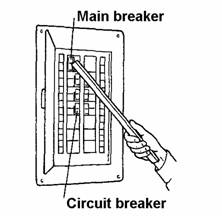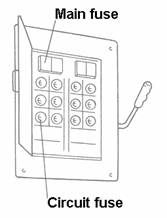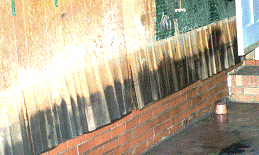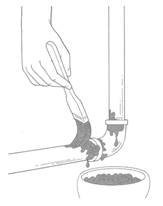Related Links
Flood Damage
There are three main causes of flood damage to buildings in South Holland: Hydrostatic pressure, soaking, and sediment and contaminants.
Hydrostatic pressure
The weight of standing water puts hydrostatic pressure on a structure. The deeper the water, the more it weighs and the greater the hydrostatic pressure. Because water is fluid, it exerts the same amount of pressure sideways as it does downward.
Therefore, as water gets deeper, it exerts more pressure than shallow water. Most walls are not built to withstand lateral pressure. Studies and tests have shown that the lateral force presented by three feet of standing water can be enough to collapse the walls of a typical frame house on a slab foundation.
Basement walls and floors are particularly susceptible to damage by hydrostatic pressure. In this context, a “basement” includes all below grade floors of a trilevel. Not only is the water deeper, a basement is subjected to the combined weight of water and saturated earth.
Basement walls can break under water pressure, as shown in the photo. Water in the ground underneath a flooded building will seek the level of the surrounding water – resulting in uplift forces that can break a concrete basement wall or floor.


| To turn off the electricity at a breaker box: 1. Stand on a dry spot. 2. Use a dry wooden stick or pole to open the door. 3. Use the stick to push the main breaker switch to OFF. 4. Use the stick to turn each circuit breaker to OFF. | To turn off the electricity at a fuse box: 1. Stand on a dry spot. 2. If your box has a handle on the side, use a dry wooden stick or pole to pull the handle to OFF. 3. Use the stick to open the door. 4. Carefully pull out the main fuses. 5. Unscrew and remove each circuit’s fuse. |
Flood Damage − Soaking

When soaked, many materials change their composition or shape. Wet wood will swell, and if it is dried too fast it will crack, split or warp. Plywood can come apart. Gypsum wallboard will fall apart if it is bumped before it dries out. The longer these materials are wet, the more moisture they will absorb.
Walls present a special problem: a “wicking” effect pulls water up through wood and wallboard, soaking materials as much as several feet above the water line, as was the case in the photo above.
Soaking can cause extensive damage to household goods. Wooden furniture may get so badly warped that it can’t be used. Other furnishings, such as upholstery, carpeting, mattresses and books, usually are not worth drying out and restoring. Electrical appliances and gasoline engines won’t work safely until they are professionally dried and cleaned.
Flood Damage − Sediment and contaminants
Few floods have clear floodwater, and so they leave a mess made of natural and man-made debris. Stormwater and snowmelt pick up whatever was on the ground, such as soil, road oil, and farm and lawn chemicals (see the photo of the bathroom).
Many materials, including wood and fiberglass or cellulose insulation, absorb floodwater and its sediment. Even if allowed to dry out, the materials will still hold the sediment and contaminants brought by the flood. Simply letting a flooded house dry out will not render it clean — and it certainly will not be as healthy a place to live as it was before the flood.
These health problems can be aggravated when heating ducts in a forced-air system are not properly cleaned after inundation. When the furnace or air conditioner is turned on, the sediments left in the ducts are circulated throughout the building and breathed in by the occupants.
 If you find any pipes that smell like gas, brush soapy water on each pipe connection. The pressure in the pipes will make bubbles appear where there is a leak.
If you find any pipes that smell like gas, brush soapy water on each pipe connection. The pressure in the pipes will make bubbles appear where there is a leak.
